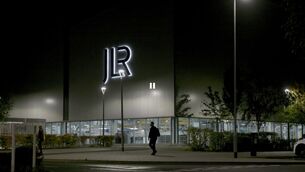Wall of separation between Church and State is far from being built

GIVEN the controversy over the ownership of the National Maternity Hospital and the Sisters of Charity, there has been much talk of the separation of the Church and the State. It is a doctrine we have scarcely come to terms with in this country. Insofar as it exists at all, it is honoured more in the breach than the observance.
The modern doctrine of the separation of Church and State is traced back to Thomas Jefferson, the main author of the American Declaration of Independence, of 1776. He was also the third president of the United States (1801-1809).
He had drafted a Bill for Religious Liberty for the state of Virginia, in 1779, and this was enacted in 1786, a year before the American constitution.
Although this latter document made no mention of God, Jefferson believed that an explicit protection against any establishment of religion by government was necessary.
He argued that a bill of rights should be added to the constitution, protecting, inter alia, freedom of speech and freedom of the press, as well as religious liberty.
Jefferson had promoted the concept of a “wall of separation” between Church and State, and this found its constitutional moorings in the first amendment. It incorporates what is known as the establishment clause (“Congress shall make no law respecting an establishment of religion...”), which is immediately followed by the free exercise clause (“or prohibit the free exercise thereof”).
The bill of rights (the collective name for the first 10 amendments of the American constitution) was ratified in 1791. Afterwards, Jefferson couldn’t hide his delight in what the first amendment represented. On January 1, 1802, he wrote, as president, a letter to the Danbury Baptist Association in Connecticut (published in a Massachusetts newspaper) as follows: “I contemplate, with sovereign reverence, that act of the whole American people, which declared that their legislature should make no law respecting an establishment of religion, or prohibiting ‘the free exercise thereof’, thus building a wall of separation between Church and State.”

Prof Stephen Carter, of Yale University, has described, in his 1994 book The Culture of Disbelief, the separation of Church and State as “one of the great gifts that American political philosophy has presented to the world”.
But he also outlines the limits of the doctrine. “The most significant aspect of the separation of Church and State is not, as some seem to think, the shielding of the secular world from too strong a religious influence; the principal task of the separation of Church and State is to secure religious liberty.”
In other words, the doctrine does not mean “that people whose motivations are religious are banned from trying to influence government, nor that the government is banned from listening to them”.
Carter says there is nothing undemocratic about religious activism and religious language in politics.
“The first amendment, and the wall of separation it supposedly erects between Church and State, have no effect whatsoever on the consciences or voices of individual citizens, as they seek to influence what government does in their names.”
What the doctrine does mean is that the State should remain neutral in regard to religion.
“The State’s neutrality is required in the interest of religious liberty,” wrote Desmond Clarke, of UCC, in his 1984 book, Church & State.
“Just as it would infringe the individual’s rights if he were coerced to believe, or not believe, against his will, so, likewise, it infringes the religious liberty of individuals, if the State uses its resources to help determine, in any way, the religious or non-religious beliefs of citizens. To respect the individual’s liberty requires the State to mind its own business.”
The neutrality of the State with respect to religion has been reaffirmed again and again by the US Supreme Court.
For instance, in Epperson v Arkansas, it ruled as follows: “Government in our democracy, state and national, must be neutral in matters of religious theory, doctrine, and practice.
“It may not be hostile to any religion or to the advocacy of no-religion; and it may not aid, foster, or promote one religion or religious theory against another, or even against the militant opposite.
“The first amendment mandates governmental neutrality between religion and religion, and between religion and non-religion.”
This neutrality is notably absent in Ireland, though the historical context must be considered.
Clarke has contrasted the US, “where the separation of Church and State is constitutionally guaranteed”, with Ireland, “where the Constitution explicitly recognises the role of religious groups in a variety of ways”.
He emphasised that the “Irish Constitution’s injunction against State endowment of any religion is hardly compatible with direct and indirect financing for religious schools at primary and secondary level and, at the third level, of a Roman Catholic seminary”. This latter is a reference to St Patrick’s College, Maynooth.
As Prof John Garvey, of Notre Dame University, has said, US citizens are “accustomed to the notion that religion and government occupy different, non-intersecting spheres of influence”.
Such a situation doesn’t pertain here. Two examples illustrate this:
(1) the Eucharistic Congress of 1932, which, as Diarmaid Ferriter has said in his book, The Transformation of Ireland, 1900-2000, “involved the close collaboration of Church, State, and citizens”
(2) the circumstances of the creation of the Constitution, Bunreacht na hÉireann, in 1937, whereby Éamon de Valera took advice from senior Church figures (and accepted much of it) in drafting the Constitution (though, as Ferriter has said, “he resisted the demand that Catholicism should be recognised as the State religion”).
Instead, he recognised its “special position”, in Article 44, a position that remained until the Fifth Amendment of the Constitution, in 1972.

But if the separation of Church and State, as outlined by Prof Garvey, does not apply here in Ireland, then one must look to history, especially the history of the 19th century.
“Any attempt to understand the power and influence of Catholicism in Irish society must examine socio-political developments in nineteenth-century Ireland,” Louise Fuller, of the NUI at Maynooth, reminds us in her excellent 2004 book, Irish Catholicism Since 1950: The Undoing of a Culture.
Significantly, one of her key chapters is entitled ‘The Legitimisation of the Catholic Ethos by the Free State and Subsequent Irish Governments’. In it, she writes: “One of the most outstanding features of Irish Catholic culture in the post-independence era was the extent to which the State, by the actions, words, and public appearances of its representatives, legitimated the Catholic ethos.
“An alliance was formed between the Catholic Church authorities and the Free State government during the Civil War years, and WT Cosgrave, during his tenure of office, looked to the Church to augment the authority of his government. The alliance was a mutually reinforcing one.
“The bishops were prepared to throw their weight behind the new State and endorse its political legitimacy, which was being contested by the anti-treaty republicans, and the rulers of the new State were not disposed to question the authority of the Church in matters having to do with education, health, or sexual morality, traditionally seen by the Church as its areas of competence.”
The tradition was deeply cemented into the prevailing culture during the 19th century, when the Catholic Church perforce took on the role of a proxy State in occupied Ireland.
In the absence of a native parliament and a native government, it fell to the Church to provide services and facilities in education and healthcare, and in the enforcement of morals, that would otherwise have been the responsibility of a democratically elected government.
It should never be forgotten (especially right now, when we have witnessed a near-hysterical tirade of criticism of the Sisters of Charity) that a great service was undertaken by the religious orders and congregations for the benefit, welfare, and wellbeing of the Irish people.
The costs and benefits of that service simply cannot be computed. This is not to turn a blind eye to the dark episodes in the history of some of these congregations, but there is also a much larger picture.
Of course, we live in a very different Ireland now, more secular and pluralistic, but to understand what Ireland was like, and how the power and influence of the Catholic Church grew to what it was in 1950 and beyond, we have to, as Fuller has sought to remind us, see things in historical perspective.
The requirement that the State should be neutral as regards religion could not be met in the circumstances of the 1920s, as the nascent State sought to establish its legitimacy, and could not be met for a long time thereafter.
The Irish State needed all the help it could get, and that help, in its most cogent form, could be provided by the Catholic Church to which the government of the day turned. An alliance was forged and it is one to which all subsequent governments adhered and contributed.
It will be argued that this alliance turned into a far too cosy arrangement, and the undoing of that culture — about which Fuller’s book offers an excellent study — continues to this day.
The unravelling of that culture has been slow and painful, and the present controversy over the National Maternity Hospital and the Sisters of Charity is but the latest manifestation of this.
The cosy alliance remained in place for far too long because, of course, for a long time it was mutually beneficial: it suited both sides, with the negative and damaging result that shameful situations, which ought to have been examined, challenged and exposed, remained under the radar and hidden.
The prevailing philosophy — bred by this cosy alliance — was live and let live. But responsibility for this alliance rests as much with the agents of the State as with the agents of the Church.
The controversy over the National Maternity Hospital and the Sisters of Charity shows, among other things, that even in the Ireland of the 21st century we are still far from being able to erect that “wall of separation” between Church and State, which Thomas Jefferson so much prized and so ably championed.















